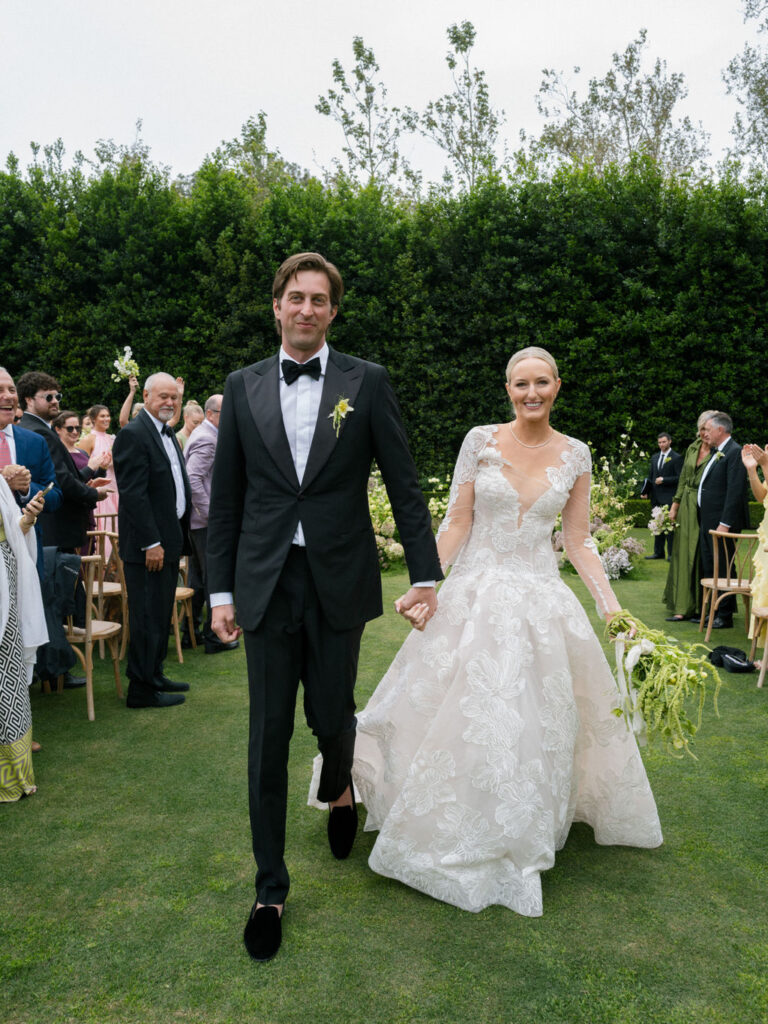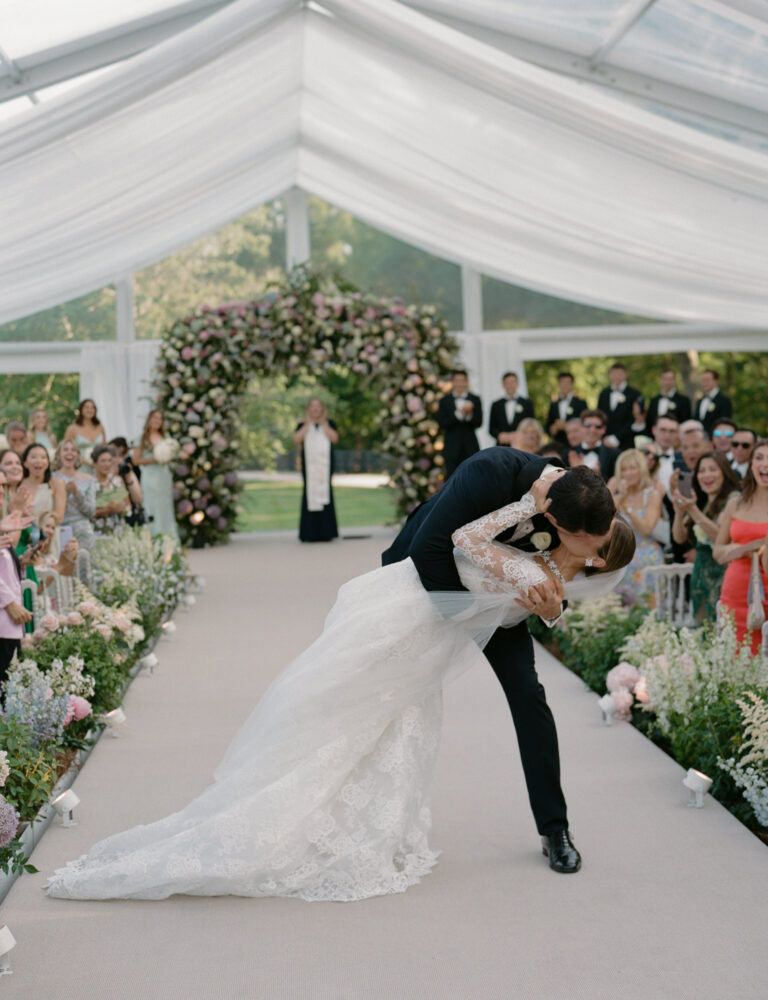Winter is here, which means there are two ways to get a tan this season: find a tropical locale or look into faking it. The good news is that spray tans have come a long way since their infamous turn on Friends, when Ross’ repeated user error led to some rather tragic results. So if your fall and winter wedding plans involve looking more like a sun-kissed goddess and less like an overbaked gingerbread cookie, then you’re in luck. We’ve consulted some of the best spray tan artists in the business to answer your most pressing questions. So, let’s get to it.
1. What is a professional spray tan, really?
While spray tanning booths are still a thing, we are going to put our foot down and say that a customized airbrush tan is the way to go. We recommend having a dedicated spray tan artist who will either come to your home or spray you in their studio. In both cases, there will be a booth or tent where you stand at different angles, while they apply a spray tan solution to your entire body with an airbrush applicator.
And what is the solution made up of, exactly? Paige Politelli, owner of Coastal Tans in Charleston, South Carolina explains, “In all spray tan solutions and in self-tanner the main ingredient is Dihydroxyacetone (DHA). That is the ingredient that changes the color of your skin. It reacts with the amino acids, the proteins, and the dead skin cells on your skin and darkens them, so that’s how you get that sunless color.”
In professional spray tan solutions, there are different percentages of DHA, with a rapid tan option having the highest percentage. While a traditional formula works overnight, a rapid tan will develop within a few hours depending on the color you are trying to achieve. A good spray tan artist will consider your skin type and your goals and customize accordingly.
As Nadia Slominski, owner of Healthy Glow Spray Tans in Nashville, Tennessee points out, “What we see being sprayed on at the time of the appointment is usually just a cosmetic bronzer which will rinse off at the time of the first shower. The “tan” part is actually a completely clear ingredient and will gradually work over the course of 24 hours to create the tan.”
So if things appear streaky at first or directly after your shower, keep calm and carry on. “It’s important for people to know that the bronzer can move around,” Politelli says. “You may see on your neck or bikini line. Nothing looks even and perfect right away. Be patient, let it work its magic and everything will even out.”
2. How do you find the right spray tan artist?
All of our experts had this to say when it comes to vetting a new spray tan artist: referrals, referrals, referrals. With a service as intimate as a spray tan, it’s always best to start with someone who came highly recommended by a friend or acquaintance. If you’re having a destination wedding and don’t know anyone in the area, you might consult the concierge of a reputable hotel.
You should also do your own research and ask questions about the solution itself. If you are traveling and want to mimic the effects of working with your local spray tan artist, Jenni Blafer of Sunkissed by Jenni in Los Angeles says, “You might ask your spray tan artist what formula they use and exactly how they use it so there is some formulation.” When vetting a new artist, she says, “Find out if they use the same solution and could possibly do the same formula.”
When it comes to the solution itself, you don’t have to become an expert, but there are a few general guidelines our experts suggest you follow. “You want to try to find something that doesn’t have a million ingredients, “ Blafer says. “I don’t think it’s necessary.”
DHA can dry out the skin, so it’s also good to look for moisturizing ingredients like aloe and hyaluronic acid to balance that out. And as Politelli suggests, for clients with a nut allergy, it’s obviously a good idea to ask your spray tan artist if the solution contains nuts.
3. What should you do to prepare?
When it comes to getting the perfect spray tan, all of our experts agree that preparation is key.
Politelli, who works to educate clients on the process, even provides a detailed timeline to follow in the days leading up to their spray tan. Politelli recommends that services such as waxing, hair, skin and nails be done 48 hours prior to your spray tan. A shower and exfoliating should happen 24 hours prior. On the day of, ditch the products like deodorant, body oils, and fragrant moisturizers. You want to arrive with completely clean skin.
Though Blafer offers one exception to this rule. She advises clients with dry skin to apply a mild moisturizer (think Cerave or Cetaphil) about two hours before treatment. “I always compare it to when you paint a wall. You always prime the wall so that the paint lays evenly any porous spots, you have a very even canvas. That’s the same for our bodies when they’re dry.”
4. What should you wear to your spray tan appointment?
What to wear to a spray tan appointment will depend slightly on if you are going to the studio or having someone come to your home.
Slominski, who works in-studio, says, “Dark and loose clothing is strongly recommended to wear directly after a spray tan. This can include sweatpants, a sun-dress, or anything else that is similar.” You’ll have to wear something on your feet for a studio visit, but you’ll want to keep footwear minimal, like a thong flip-flop vs. a pair of running shoes with socks.
For Politelli, who has a fully mobile business, she encourages her clients to wear whatever makes them comfortable during the tan. For some this means a disposable thong and for those wanting to avoid lines, nothing at all. Following the tan, the rules are similar. Politelli says, “I always say no bra, no shoes, if they can. Something that’s very loose. You don’t wear anything that’s restrictive. Tight tank tops, jeans, leggings, nothing like that. If you have a little slip dress you can throw on or baggy sweatpants or a baggy t-shirt. It’s not very glamorous but it is what’s best for after a spray tan.”
In other words, you want to avoid any garments that might rub against your skin and potentially remove the solution.
5. How do you take care of your tan?
To extend the life of your spray tan, the most important thing is to focus on hydrating the body, inside and out, particularly if you’ll be traveling.
Blafer says, “Hydrate, hydrate, hydrate. Moisturize. Drink water. That will surely extend your tan.”
Politelli says using the right products is key and suggests moisturizing from head-to-toe with something basic, avoiding mineral oils, heavy fragrances, and other harsh ingredients.
6. Are there any special considerations for brides?
The most consistent advice when it comes to brides and spray tans specifically came down to trials. Similar to hair and make-up, you should know exactly how your spray tan will turn out before the big day. This means scheduling a trial a few months in advance so you and the spray tan artist can work together to perfect the shade. As Politelli explains, “Spray tanning is not one size fits all. Everyone in the world could be sprayed with the same solution and we’ll all turn out differently. Trials are huge.” If, worst case scenario, you have an allergic reaction, this is not something you want to learn just before walking down the aisle.
Blafer concurs, “We always have brides do trials. We have them do trials when they’re doing a fitting and a make-up test, that’s the ideal scenario. That way they can see the coloring and how it goes with their make-up and their dress.” Blafer also suggests paying attention to the timeline of your spray tan. If you’ll be traveling for a destination wedding and need to spray tan four days prior to the wedding, make sure to pay attention to how the tan fades after your trial. Blafer adds, “I want them to test the longevity and see how their skin holds up.”
Another consideration for brides: it’s important to remember that by the time you have full make-up and a white or ivory dress, your tan will appear one to two shades darker. “Less is more,” Blafer says, “You never want to look back on your pictures and see that you were tan.”
The zeitgeist tends to agree, with current trends moving away from the super dark tropical tan and more toward a golden glow. Blafer, who was tagged by client Dan Levy on his Met Gala post, says celebrities tend to set the stage and, “Right now, we’re having a natural, glowy moment.”
Finally, when running the gauntlet of wedding day beauty preparation, it’s important to remember that spray tanning is your last stop. Hair, nails, waxing, massages, facials, etc. everything else comes first.
7. What common mistakes should you avoid?
Showering too close to the appointment or to soon or too long after a spray tan is a common mistake that’s easily avoided. It’s important to listen to your spray tan artist and shower precisely within the window they advise. Shower too soon and you may not see the benefits. Wait too long and you could turn orange.
Politelli tends to see a lot of clients, particularly brides, who wash their hands too often, making the tan fade unevenly. “On your wedding day,” Politelli says, “You’re going to have a lot of photos taken of your hands. I really try to tell my clients to be careful with your hands. Especially from the time I spray them until the time they rinse.” This means keeping your hands as dry as possible. No washing the dishes or doing laundry. Also, beware of pets licking the solution!
8. What if something goes wrong?
Though spray tans have come a long way and can be a fabulous solution for many skin types, it’s still important to have a plan if something goes wrong. One of the many advantages to using a spray tan artist to a booth is you have an actual person to reach out to with any issues.
And a call or text to your artist should be your first line of defense.
“Google is not your friend,” Politelli says.
“As long as you’re doing it a few days ahead of time, anything is fixable,” says Blafer, “and if you have your artist around, anything’s fixable.”
For anyone traveling, Blafer suggests bringing multiple make-up brushes and a gradual self-tanner so you can even out the color in any spots that need attention.
The one issue your artist may not be able to help with? Peeling.
“Peeling is a bad one,” Blafer says. “There’s no fixing that. If someone had a sunburn, but they didn’t tell us, their skin is very fragile. It’s been damaged. When you spray over that, it looks nice and fine, but then it can crack your layers of skin and break them open which will expose new skin which is white.”
So, if you are dealing with a sunburn of any kind, it’s best to wait until it’s totally healed before getting a spray tan.












